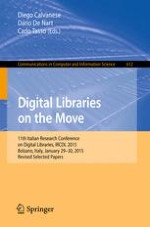This book constitutes the thoroughly refereed proceedings of the 11th Italian Research Conference on Digital Libraries, IRCDL 2015, held in Bozen-Bolzano, Italy, in January 2015.
The 13 full papers, 4 short papers and 2 invited poster papers presented were carefully selected from 19 submissions. They are organized under the following five categories: semantic modeling; projects; models and applications; content analysis; and digital libraries infrastructures. The papers deal with numerous multidisciplinary aspects ranging from computer science to humanities in the broader sense, including research areas such as archival and library information sciences; information management systems; semantic technologies; information retrieval; new knowledge environments; new organizational/business models.
